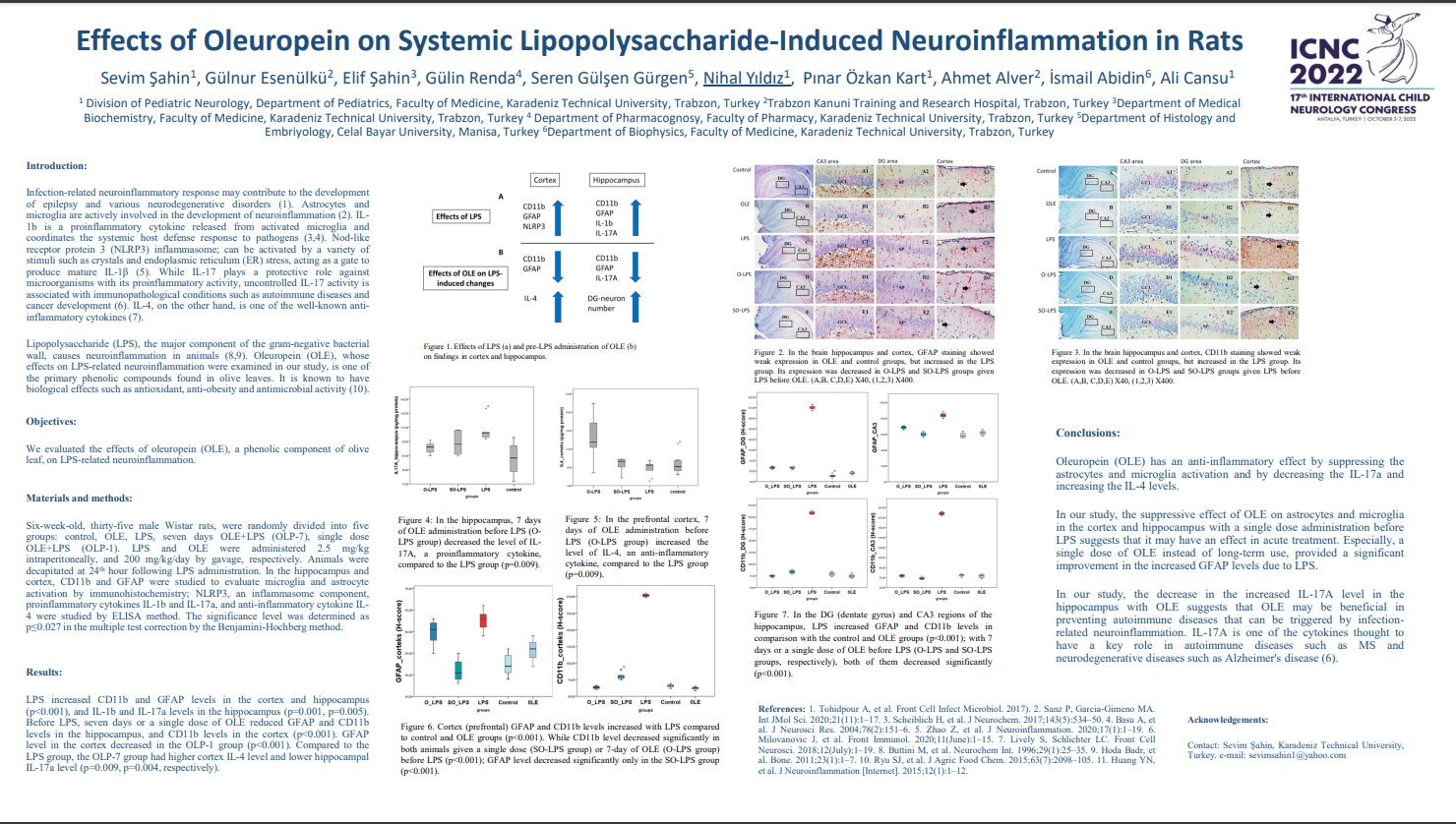Effects of Oleuropein on Systemic Lipopolysaccharide-Induced Neuroinflammation in Rats
Sevim Şahin, Gülnur Esenülkü, Elif Şahin, Gülin Renda, Seren Gülşen Gürgen, Nihal Yıldız, Pınar Özkan Kart, Ahmet Alver, İsmail Abidin, Ali Cansu
Objectives: Infection-related neuroinflammatory response may contribute to the development of epilepsy and various neurodegenerative disorders. Lipopolysaccharide (LPS), the major component in the cell wall of gram-negative bacteria, causes neuroinflammation in animals. We evaluated the effects of oleuropein (OLE), a phenolic component of olive leaf, on LPS-related neuroinflammation. Methods: Six-week-old, thirty-five male Wistar rats, were randomly divided into five groups: control, OLE, LPS, seven days OLE+LPS (OLP-7), single dose OLE+LPS (OLP-1). LPS and OLE were administered 2.5 mg/kg intraperitoneally, and 200 mg/kg/day by gavage, respectively. Animals were decapitated at 24th hour following LPS administration. In the hippocampus and cortex, CD11b and GFAP were studied to evaluate microglia and astrocyte activation by immunohistochemistry; NLRP3, an inflammasome component, proinflammatory cytokines IL-1b and IL-17a, and anti-inflammatory cytokine IL-4 were studied by ELISA method. The significance level was determined as p≤0.027 in the multiple test correction by the Benjamini-Hochberg method. Results: LPS increased CD11b and GFAP levels in the cortex and hippocampus (p<0.001), and IL-1b and IL-17a levels in the hippocampus (p=0.001, p=0.005). Before LPS, seven days or a single dose of OLE reduced GFAP and CD11b levels in the hippocampus, and CD11b levels in the cortex (p<0.001). GFAP level in the cortex decreased in the OLP-1 group (p<0.001). Compared to the LPS group, the OLP-7 group had higher cortex IL-4 level and lower hippocampal IL-17a level (p=0.009, p=0.004, respectively) (Figure-1). Conclusion: Oleuropein showed an anti-inflammatory effect by suppressing the astrocytes and microglia activation and by decreasing the IL-17a and increasing the IL-4 levels.
Keywords: lipopolysaccharide, neuroinflammation, oleuropein
Sevim Şahin
Karadeniz Technical University
Turkey
Gülnur Esenülkü
Trabzon Kanuni Training and Research Hospital
Turkey
Elif Şahin
Karadeniz Technical University
Turkey
Gülin Renda
Faculty of Pharmacy, Karadeniz Technical University
Turkey
Seren Gülşen Gürgen
Celal Bayar University
Turkey
Nihal Yıldız
Karadeniz Technical University
Turkey
Pınar Özkan Kart
Karadeniz Technical University
Turkey
Ahmet Alver
Karadeniz Technical University
Turkey
İsmail Abidin
Karadeniz Technical University
Turkey
Ali Cansu
Karadeniz Technical University
Turkey
Objectives: Infection-related neuroinflammatory response may contribute to the development of epilepsy and various neurodegenerative disorders. Lipopolysaccharide (LPS), the major component in the cell wall of gram-negative bacteria, causes neuroinflammation in animals. We evaluated the effects of oleuropein (OLE), a phenolic component of olive leaf, on LPS-related neuroinflammation. Methods: Six-week-old, thirty-five male Wistar rats, were randomly divided into five groups: control, OLE, LPS, seven days OLE+LPS (OLP-7), single dose OLE+LPS (OLP-1). LPS and OLE were administered 2.5 mg/kg intraperitoneally, and 200 mg/kg/day by gavage, respectively. Animals were decapitated at 24th hour following LPS administration. In the hippocampus and cortex, CD11b and GFAP were studied to evaluate microglia and astrocyte activation by immunohistochemistry; NLRP3, an inflammasome component, proinflammatory cytokines IL-1b and IL-17a, and anti-inflammatory cytokine IL-4 were studied by ELISA method. The significance level was determined as p≤0.027 in the multiple test correction by the Benjamini-Hochberg method. Results: LPS increased CD11b and GFAP levels in the cortex and hippocampus (p<0.001), and IL-1b and IL-17a levels in the hippocampus (p=0.001, p=0.005). Before LPS, seven days or a single dose of OLE reduced GFAP and CD11b levels in the hippocampus, and CD11b levels in the cortex (p<0.001). GFAP level in the cortex decreased in the OLP-1 group (p<0.001). Compared to the LPS group, the OLP-7 group had higher cortex IL-4 level and lower hippocampal IL-17a level (p=0.009, p=0.004, respectively) (Figure-1). Conclusion: Oleuropein showed an anti-inflammatory effect by suppressing the astrocytes and microglia activation and by decreasing the IL-17a and increasing the IL-4 levels.
Keywords: lipopolysaccharide, neuroinflammation, oleuropein
Sevim Şahin
Karadeniz Technical University
Turkey
Gülnur Esenülkü
Trabzon Kanuni Training and Research Hospital
Turkey
Elif Şahin
Karadeniz Technical University
Turkey
Gülin Renda
Faculty of Pharmacy, Karadeniz Technical University
Turkey
Seren Gülşen Gürgen
Celal Bayar University
Turkey
Nihal Yıldız
Karadeniz Technical University
Turkey
Pınar Özkan Kart
Karadeniz Technical University
Turkey
Ahmet Alver
Karadeniz Technical University
Turkey
İsmail Abidin
Karadeniz Technical University
Turkey
Ali Cansu
Karadeniz Technical University
Turkey

Nihal Yıldız
Karadeniz Technical University Turkey
Karadeniz Technical University Turkey